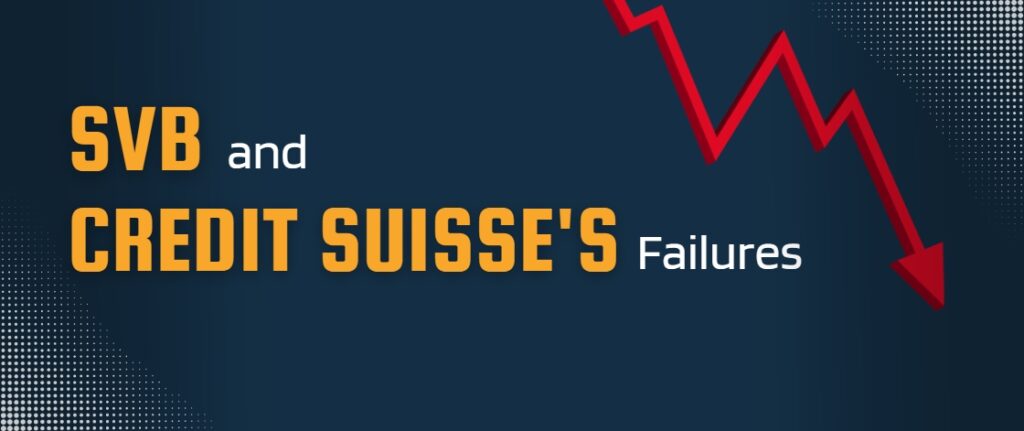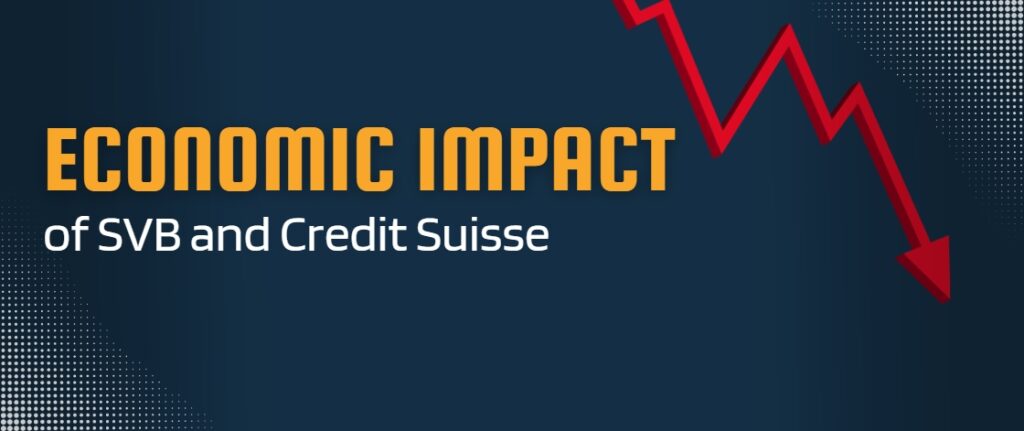The global financial industry is no stranger to economic crises. And it has been on edge following the failures of Silicon Valley Bank (SVB) and Credit Suisse. The failures have raised concerns about the state of the current economic climate, particularly given the similarities to the 2008 financial crisis. The 2008 financial crisis caused widespread devastation, and the lessons learned from that experience continue to impact financial institutions’ policies today.
This article analyzes the similarities and differences between the current economic climate and the 2008 financial crisis, providing insights into how financial institutions can avoid similar failures, and discusses the potential impact of SVB and Credit Suisse’s failures on the global financial industry.
SVB and Credit Suisse Failures

Silicon Valley Bank (SVB) is a US-based financial institution that specializes in lending to technology startups. Fresh out of the oven is the collapse of the bank. SVB collapsed after inadequate diversification and a classic bank run, leaving the whole industry in shock. Before its descent, in 2021 also, SVB suffered a significant data breach that exposed sensitive information about its clients. The breach not only threatened the privacy and security of SVB’s clients but also raised questions about the bank’s risk management practices.
Credit Suisse, a Swiss-based financial institution, has been the highlight of the past week. Credit Suisse was rescued from near bankruptcy last weekend by UBS, which is as good as a collapse. Suisse has faced significant losses due to its exposure to Archegos Capital, a family office that defaulted on margin calls. Losses are in billions of dollars, and the incident raised concerns about the bank’s risk management and compliance practices.
The failures of SVB & Credit Suisse demonstrate that even established financial institutions can make significant errors that could have far-reaching consequences.
Economic Impact of SVB and Credit Suisse

The failures of SVB and Credit Suisse have the potential to impact the global financial industry in several ways.
First, there is concern that the failures could lead to a loss of confidence in the financial sector. This could cause investors to withdraw their funds from other financial institutions, leading to a broader financial crisis.
Second, there is concern that the failures could lead to increased financial sector regulation. If governments and regulators perceive that the failures are indicative of broader problems in the industry, they may take steps to impose stricter regulations on financial institutions.
The impact of these failures is likely to be felt most strongly in the US and Europe. SVB’s failure, in particular, is a significant blow to the US fintech industry, which has been a key driver of innovation and growth in the financial sector. Additionally, Credit Suisse is one of the largest banks in Switzerland, and its failure could have significant knock-on effects on the Swiss economy.
If you need some ideas about what to read next, here they are:
Comparison of the Current Economic Situation with the 2008 Financial Crisis:

To understand how these failures relate to the 2008 financial crisis, it is necessary to examine the similarities and differences between the current economic climate and that of 2008.
One similarity between the two periods is the presence of asset bubbles. In the years leading up to the 2008 crisis, there was a significant increase in the value of housing and other assets, fueled by low-interest rates and lax lending practices. Similarly, in recent years, there has been a significant increase in the value of tech stocks and other assets, fueled by low-interest rates and easy access to capital. This increase in asset values could be a precursor to a potential bubble burst, similar to what occurred in 2008.
Another similarity between the two periods is the presence of excessive risk-taking by financial institutions. In the years leading up to the 2008 crisis, financial institutions engaged in risky practices such as subprime lending and excessive leverage. Similarly, in recent years, financial institutions have engaged in risky practices such as lending to unprofitable startups and engaging in high-risk trading activities. The failures of SVB and Credit Suisse illustrate the potential consequences of such risk-taking.
However, there are also significant differences between the current economic climate and that of 2008. One key difference is the response of governments and financial institutions to the crises. In 2008, governments and central banks worldwide implemented significant monetary and fiscal stimulus measures to prop up the economy. In contrast, in response to the COVID-19 pandemic, governments and central banks have implemented even more significant stimulus measures, including massive liquidity injections into financial markets. While these measures have helped stabilize the economy in the short term, they could also have significant long-term consequences, such as inflation and asset bubbles.
One key difference between the two crises is the cause. The 2008 financial crisis was caused by an overreliance on subprime mortgages, whereas the current economic climate resulted from a global pandemic. The pandemic has caused widespread job losses and reduced consumer spending, leading to a decline in economic activity. However, the pandemic has also led to an increase in demand for specific industries, such as technology and e-commerce.
Another difference is the impact on financial institutions. The 2008 crisis led to the failure of numerous banks and financial institutions, causing a domino effect that spread throughout the economy. In comparison, the current crisis has had a more uneven impact on financial institutions. Some institutions, such as investment banks and hedge funds, have performed well due to increased market volatility. However, other institutions, such as community banks and credit unions, have struggled due to the economic downturn.
One significant difference is that financial institutions today have more substantial capital and liquidity buffers than they did in 2008. This has enabled them to better withstand the economic shock caused by the pandemic. Additionally, many governments around the world have implemented fiscal and monetary policies to support their economies, which has helped mitigate the impact of the downturn on financial institutions.
Actionable Insights for Leading Financial Institutions to Protect Themselves & their Customers

In light of these risks, leading financial institutions need to take steps to protect themselves and their customers. Here are some recommendations for how they can do so:
- Strengthen Risk Management & Internal Controls- Financial institutions should ensure robust risk management and internal control frameworks are in place. This includes ensuring that they have adequate oversight and governance structures and effective risk assessment and monitoring processes.
- Invest in Diversified Portfolios- Financial institutions should diversify their portfolios to reduce their exposure to any particular sector or asset class. This can help to mitigate the impact of any potential losses.
- Invest in Technology & Innovation- Financial institutions should continue to invest in technology and innovation to improve their products and services and their risk management capabilities. This can help them stay competitive and better withstand any potential shocks to the industry.
- Collaborate with Regulators & other Stakeholders- Financial institutions should collaborate with regulators and other stakeholders to ensure that they are aware of any potential risks in the industry and are taking steps to address them. This can help build trust and confidence in the financial sector.
The Bottom Line
The failures of SVB and Credit Suisse are a stark reminder of the importance of strong risk management practices in the global financial industry. The similarities between the current economic situation and the 2008 financial crisis highlight the need for financial institutions to take proactive measures to protect themselves and their customers from similar failures in the future. By strengthening their risk management practices, increasing transparency, diversifying investments, and strengthening regulatory oversight, leading financial institutions can mitigate the risks of similar failures and ensure the long-term stability of the global financial system.
Frequently Asked Questions:
What does Credit Suisse do in India?
Credit Suisse operates as an investment bank in India. It provides services such as investment banking, wealth management, and securities trading to clients. Credit Suisse has been present in India since 2008 and has offices in Mumbai, Pune, and Bangalore.
What caused the failures of Silicon Valley Bank (SVB) and Credit Suisse?
Causes of the failures of SVB and Credit Suisse:
SVB- inadequate diversification and a classic bank run, during which a large number of customers withdrew their deposits simultaneously.
Credit Suisse- The bank’s questionable acquisitions and repeated penalties had jeopardized its reputation, resulting in a significant decline in all its businesses.
What are some other examples of global financial failures?
The 2008 financial crisis is a prominent example of a global financial failure with significant economic consequences. Other examples include the collapse of Lehman Brothers in 2008, the 1997 Asian financial crisis, and the 2012 banking crisis in Cyprus.
Join Our Newsletter
Elevate your financial game & join the ranks of elite investors with Secvolt’s exclusive newsletter.
Join Our Newsletter
Elevate your financial game & join the ranks of elite investors with Secvolt’s exclusive newsletter.
Don’t just dream of wealth; achieve it with Secvolt. Schedule a call today for personalized guidance on your investment strategy and join the ultra-successful.
Ready to unlock your wealth’s truest potential & cherish affluence?
Secvolt, our hedge fund, sets the bar high with a record-breaking performance of 262% returns in 2022. With the brilliance of our highly advanced quant models and the efficiency of our risk mitigation protocols, we are yet to see a loss!
We’re the perfect ally to help you succeed financially and build the lasting legacy you have always aspired for.
Get in touch today. YOUR LEGACY AWAITS YOU…





